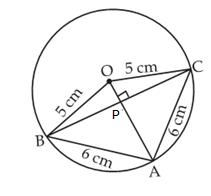Ask questions which are clear, concise and easy to understand.
Ask QuestionPosted by Palak Chaudhari 5 years, 1 month ago
- 5 answers
Dhanusri V 5 years, 1 month ago
Yogita Ingle 5 years, 1 month ago
A tangent to a circle is a line which intersects the circle at only one point. The common point between the tangent and the circle are called the point of contact.
Line AB touches the circle exactly at one point, P. Such a line is called the tangent to the circle.

Krishna Varshney 5 years, 1 month ago
Posted by Endla Gurucharan 5 years, 1 month ago
- 2 answers
Posted by Soniya Rana 5 years, 1 month ago
- 3 answers
Open Beast 5 years, 1 month ago
Vandana 🇮🇳 5 years, 1 month ago
Posted by Cheshta Dhawan 5 years, 1 month ago
- 1 answers
?Suhani Arora? 5 years, 1 month ago
Posted by Tanay Shirke 5 years, 1 month ago
- 2 answers
Yogita Ingle 5 years, 1 month ago
Examples of abiotic factors include sunlight, water, air, humidity, pH, temperature, salinity, precipitation, altitude, type of soil, minerals, wind, dissolved oxygen, mineral nutrients present in the soil, air and water, etc.
Posted by Dishanth Mondal 5 years, 1 month ago
- 2 answers
Posted by Aditya Chauhan 5 years, 1 month ago
- 1 answers
Yogita Ingle 5 years, 1 month ago
Given tan2A=cot(A−180)
⇒cot(90−2A)=cot(A−180)[∵tanθ=cot(90−θ)]
Comparing angles we get
90−2A=A−18
⇒90+18=A+2A
⇒3A=108
⇒A=108/3
⇒A=36∘
Posted by Yaju Tatak 5 years, 1 month ago
- 5 answers
Posted by Vaishnavi Shukla 5 years, 1 month ago
- 1 answers
Gaurav Seth 5 years, 1 month ago
Putting Value of X and Y , in LHS we get,
→ (2/x+y)² + (x-y/2)²
→ (2/secA + sinA + secA - sinA)² + (secA + sinA - (secA - sinA)/2)²
→ (2/2secA)² + (secA + sinA - secA + sinA)/2)²
→ 1/sec²A + (2sinA/2)²
[using 1/secA = cosA ]
→ cos²A + sin²A
[ Now , we know that, cos²A + sin²A = 1 ]
Hence,
→ 1 = RHS ( Proved )
Posted by Piyush Tiwari 5 years, 1 month ago
- 3 answers
Anushika Singhal 5 years, 1 month ago
Posted by Shivansh Yadav 5 years, 1 month ago
- 1 answers
Priya ✧*。٩(๑˙╰╯˙๑)و✧*。 5 years, 1 month ago
Posted by M. Srimathi 5 years, 1 month ago
- 3 answers
Posted by Paru ? 5 years, 1 month ago
- 2 answers
Gaurav Seth 5 years, 1 month ago
first term of Ap=1
common difference=4
hence nth term (tn)=a+(n-1) d
only that number is ppossible in AP which gives integer value of n
now calculate n for each number,
(1) 7881=1+(n-1) 4
7880/4=1970=n
n gain integer value so , 7881 is In Ap
(2) 13531=1+(n-1) 4
13530/4=3382.5 =n
this is not possible
(3) 10091=1+(n-1) 4
10090/4=2522.5 =n
this is also not possible
(4) 4551=1+(n-1) d
4550/4=1137.5 =n
hence this is not possible
Posted by Sahiti Pavani 5 years, 1 month ago
- 0 answers
Posted by Sahiti Pavani 5 years, 1 month ago
- 0 answers
Posted by Manya Mahajan 5 years, 1 month ago
- 5 answers
Divyam Mishra 5 years, 1 month ago
Afsana Khatun 5 years, 1 month ago
Ayush Pandey 5 years, 1 month ago
Posted by Vandana 🇮🇳 5 years, 1 month ago
- 0 answers
Posted by Amrita Maurya 5 years, 1 month ago
- 3 answers
Piyush Tiwari 5 years, 1 month ago
Ayush Pandey 5 years, 1 month ago
Manya Mahajan 5 years, 1 month ago
Posted by Vandana 🇮🇳 5 years, 1 month ago
- 2 answers
Gaurav Seth 5 years, 1 month ago

Given - AB and AC are two equal words of a circle, therefore the centre of the circle lies on the bisector of  BAC.
BAC.
 OA is the bisector of
OA is the bisector of  BAC.
BAC.
Again, the internal bisector of an angle divides the opposite sides in the ratio of the sides containing the angle.
 P divides BC in the ratio = 6 : 6 = 1 : 1.
P divides BC in the ratio = 6 : 6 = 1 : 1.
 P is mid-point of BC.
P is mid-point of BC.
 OP
OP  BC.
BC.
In  ABP, by Pythagoras theorem,
ABP, by Pythagoras theorem,

In right  OBP, we have
OBP, we have

Equating (1) and (2), we get

Putting AP in (1), we get

or,alternate method:

Area of  AOB by Heron's formula
AOB by Heron's formula

ar AOB) =
AOB) = 

Also ar AOB =
AOB = 


BM = h = 4.8 cm
BC = 2 BM = 9.6 cm.
Posted by Shubh Patel 5 years, 1 month ago
- 1 answers
Yogita Ingle 5 years, 1 month ago
(sin72° + cos18°)(sin72° − cos18°).
= (sin2 72° – cos2 18°)
= (sin2 72° – cos2 (90° – 72°)
= sin2 72° – sin2 72°
= 0
Posted by G Mahesh Gadla 5 years, 1 month ago
- 0 answers
Posted by Daxita Jain 5 years, 1 month ago
- 2 answers
Swarnima Verma 5 years, 1 month ago
Posted by Disha Gour 5 years, 1 month ago
- 1 answers
Pragati Verma 5 years, 1 month ago
Posted by Manish Agarwal 5 years, 1 month ago
- 2 answers
Gaurav Seth 5 years, 1 month ago
Given diameter of the circular pipe = 2 cm
So, the radius of the circular pipe = 2/2 = 1 cm
Height of the circular pipe = 0.7 m = 0.7 * 100 = 70 cm
Now, volume of the water flows in 1 second = πr2 h
= 3.142 * 12 * 70
= 3.142 * 70
Volume of the water flows in 1/2 hours = 3.142 * 70 * 30 * 60
Now, volume of the water flows = Volume of the cylinder
=> 3.142 * 70 * 30 * 60 = πr2 h
=> 3.142 * 70 * 30 * 60 = 3.142 * (40)2 h
=> 70 * 30 * 60 = 40 * 40 * h
=> h = (70 * 30 * 60)/(40 * 40)
=> h = (70 * 3 * 6)/(4 * 4)
=> h = 1260/16
=> h = 78.85 cm
So, the level of water rise in the tank in half an hour is 78.75 cm
Posted by Rohit Yadav 5 years, 1 month ago
- 2 answers
Vaishu ? 5 years, 1 month ago
Yogita Ingle 5 years, 1 month ago
x2 - 3 = 0
x2 - ( √ 3)2 =0
(x - √ 3) (x + √ 3)=0
x - √ 3=0 and x + √ 3=0
x = √3 and x = - √3
Posted by Bollapelli Sathwika 5 years, 1 month ago
- 0 answers
Posted by Femi Femi 5 years, 1 month ago
- 1 answers
Yogita Ingle 5 years, 1 month ago
Given numbers: 135 and 225
Here, 225>135.
So, we will divide greater number by smaller number.
Divide 225 by 135.
The quotient is 1 and remainder is 90.
225=135×1+90
Divide 135 by 90
The quotient is 1 and remainder is 45.
135=90×1+45
Divide 90 by 45.
The quotient is 2 and remainder is 0.
90=2×45+0
Thus, the HCF is 45.

myCBSEguide
Trusted by 1 Crore+ Students

Test Generator
Create papers online. It's FREE.

CUET Mock Tests
75,000+ questions to practice only on myCBSEguide app
 myCBSEguide
myCBSEguide
Navneet Kaur 5 years, 1 month ago
0Thank You